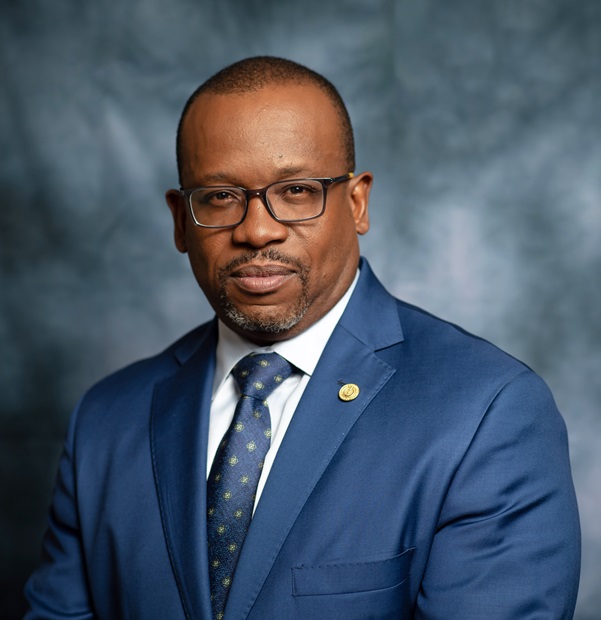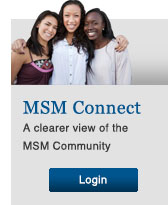US Medical Schools Grapple with First Admissions Since End of Affirmative Action
Morehouse School of Medicine Dean and Executive Vice President of Health Affairs Dr. Joseph Adrian Tyndall is interviewed by Bloomberg News about the ramifications of the recent Supreme Court ruling.
 Dr. Joseph Adrian Tyndall
Dr. Joseph Adrian Tyndall
Morehouse School of Medicine Dean and Executive Vice President of Health Affairs
By Richard Abbey, Ilena Peng and Marie Patino, Bloomberg News
American medical schools are confronting their first major challenge since the US Supreme Court’s June decision to outlaw race-based college admissions.
As medical schools sift through their first round of applications since the ruling, there’s already a nascent response to diminish the impact on the pipeline of future Black doctors.
The National Medical Association, an organization for Black physicians, is raising money for a new scholarship. The Association of American Medical Colleges will get involved in K-12 education for the first time.
Underrepresentation is a long-standing problem: only 5.2% of practicing physicians in the US were Black even before the ruling, despite Black people making up about 14% of the overall population.
But participants at multiple stages of the education process say the ruling laid bare the urgency of eliminating systemic obstacles, many of which begin a lot earlier in a potential medical student’s life than college.
“Underrepresentation has been a consistent problem over many decades,” said Reynold Verret, president of Xavier University of Louisiana, one of about 100 Historically Black Colleges and Universities. “If we do not come to other solutions to bring representation and diversity across our hiring system, you may see fewer students of color at some of our elite institutions.”
The cost of the disparity is substantial, showing up in worse health outcomes for Black patients and deteriorating trust in the healthcare system.
Experts say there’s no single solution; instead, hurdles from the earliest years of education through medical school and beyond must be removed.
The high court’s decision brings full circle its history of dealing with race and medical education in particular — its landmark 1978 decision in Regents of the University of California v. Bakke struck down racial quotas at a University of California medical school while allowing schools to consider race in admissions.
Here’s a snapshot of where barriers to entry crop up throughout the pipeline for potential Black doctors:
Early Education
It begins in kindergarten, where as few as 3% of Black students display advanced mathematics or science compared with up to 16% of White students, a 2022 study in Gifted Child Quarterly found. The disparities were strongly linked to the greater likelihood of the Black students' families experiencing economic disadvantage, according to the study, whose authors advocated for programs to increase racial and ethnic representation in STEM subjects to start in elementary school.
At times, teachers can also be discouraging, as Charles Farmer, an emergency physician at Summit Health in New Jersey, found out. When a 12-year-old Farmer expressed an interest in becoming a doctor, his teacher said he wasn’t great at math and wished him luck. “I was one of the only few African Americans and you already feel like you have to compete with your classmates because you want to show that you belong,’’ Farmer, 30, said in an interview. “When you hear stuff like that it makes you feel like you don’t belong.”
In high school, Black student representation falls short in the math and science courses highlighted by the AAMC as useful to prepare for medical training.
The SCOTUS ruling highlighted how “we have more work to do” to create more Black doctors, said Geoffrey Young, who runs the AAMC’s program to improve diversity in medicine. The group is looking for partner organizations to develop a mentorship program for young students. It’s also advising its member schools on retooling their admissions processes, offering data and help on new approaches such as expanding their network of potential applicants.
Medical Schools
Parents’ education plays an important role. Medical students of any race are more likely to come from households where parents have a bachelor’s degree or higher. This narrows the pool: 28% of Black adults age 25 and older have completed college, compared with 42% of White adults.
The likelihood a Black college student will continue to medical school is also closely linked to where they do their undergraduate studies, and HBCUs produce a disproportionate share. Close to 5% of all Black applicants to medical school in the current term came from three HBCUs — Howard University, Spelman College and Xavier — according to AAMC data, even though HBCUs overall account for less than 2% of US bachelor’s degrees.
The pattern is repeated at medical school. Out of the latest graduating class of about 20,920, almost 7% were Black, according to AAMC data. Three HBCUs — Howard, Morehouse School of Medicine and Meharry Medical College — accounted for 182, or 13%, of these Black graduates.
HBCUs expect more applications following the SCOTUS ruling, and have warned that the influx could strain their resources. The combined endowment of all HBCUs was about $3.9 billion in 2019, according to the Brookings Institution. That’s less than a tenth of the $41 billion for Harvard University that same year.
“HBCUs are less capable of funding these students with the kinds of scholarship dollars that other universities or institutions with large endowments can,” Joseph Adrian Tyndall, MD, MPH, Dean and Executive Vice President of Health Affairs at Morehouse School of Medicine, said in an interview. “The resources have been lopsided.”
Two new medical schools, both connected to HBCUs, are aiming to help improve diversity in healthcare.
The Maryland College of Osteopathic Medicine at Morgan State in Baltimore plans to start accepting students in 2025. It wants to create a pipeline of practitioners who will return to provide care in their local communities, John Sealey, the school’s founding dean, said in an interview.
Xavier University of Louisiana, which is also setting up a college of medicine, hasn’t finalized the date for accepting new students. President Verret said the HBCU network is ready to play its role, but it’s “not the wealthiest in the country,” and new facilities require a lot of investment.
Medical Debt
There’s also the enormous cost of medical school. Almost a quarter of medical students come from the richest 5% of households, according to research in the Journal of the American Medical Association. Just 1.7% of Black non-Hispanic families landed in that top income bracket, the smallest share for any race.
David Hallo, 29, finished a pre-med program in 2017 at the University of Virginia with around $15,000 of student loans. He said he’s postponing medical school so he can work full time to pay it off, and is concerned about adding $250,000 of debt to cover a four-year program.
“Going back to medical school as a full-time student is one of my biggest fears,” Hallo said in an interview. “I ask myself: How am I going to juggle this and be able to take on more loans?”
About three-quarters of medical school graduates in 2019 had education debt, and the median amount for those borrowers was $200,000, AAMC data show. The burden weighed heaviest on Black, non-Hispanic graduates both by share of debt (91%) and median amount ($230,000). Students of other races borrowed less.
After the high court ruling, the NMA said it will raise $1 million to fund scholarships to help tackle the shortage of Black doctors in the US. It will provide an update on its progress in August, an NMA representative said.
The end of affirmative action makes it even more critical to boost representation of Black students in medical schools, said Kameron Matthews, co-founder of Tour for Diversity in Medicine, an initiative to bring people of diverse racial and ethnic backgrounds into the field.
“This is now going to be a driving motivation for us,” she said. “These students are facing a very steep uphill battle of even getting into the health profession.”
Michael R. Bloomberg, the majority owner of Bloomberg News parent Bloomberg LP, and his charitable foundation, Bloomberg Philanthropies, support HBCU medical schools and other health and diversity programs.

